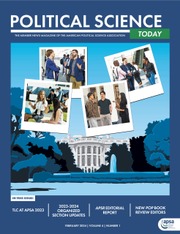191 institutions responded to APSA’s 2022-2023 Departmental Survey, which was administered between November 2023 and February 2024. Institutions provided information about the number of political science degrees awarded, enrollments in political science programs, the types and number of faculty employed, and faculty salaries and benefits. Despite a lower rate of survey responses than in previous years, the data reported is largely consistent with historical trends. For any questions, please contact us at [email protected].

Figure 1. Average Number of Faculty Employed
Public institutions generally employed more faculty, both tenure- and non-tenure-track, than private institutions. Both institution types generally employed more tenure-track than non-tenure-track faculty.

Figure 2. Average Salary (USD/year) by Faculty Rank
Public institutions, on average, paid slightly more than private institutions across all faculty ranks. This is a reversal from data reported in previous years (see the 2017-2018 Departmental Survey report).

Figure 3. Average number of degrees granted in 2022-2023 by political science departments
On average, public institutions awarded markedly more BAs in 2022-2023 than did private institutions, and awarded a slightly higher number of MAs as well. The number of PhDs awarded was nearly identical between public and private institutions.

Figure 4. Undergraduate Student Enrollments by Institution and Department Type
PhD-granting departments enrolled the largest number of BA students in 2022-2023 at both public and private institutions. MA-granting departments enrolled the next-largest number of BA students, though the advantage was much larger for private institutions than public ones.






